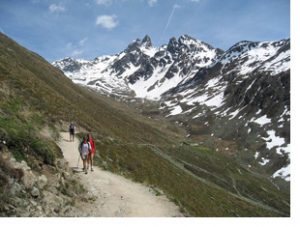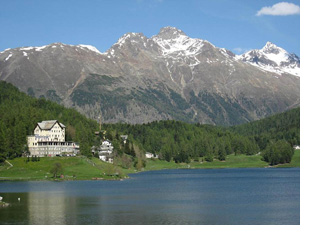by Caroline M. Jackson
 Glitzy St. Moritz is renown as one of the world’s top ski destinations but when its snowy mantle has melted, summer visitors can also enjoy the ambience of this mountain resort. Located in the southeastern canton of Graubunden, a snowball throw from the Italian border, our scenic train journey from Zurich airport took less than four hours. On arriving at the train station we discovered St. Moritz is really a twin resort: St. Moritz- Bad (Spa) by the lake and St. Moritz-Dorf (Village) where the Jet Set sleep and party after schussing down the ski slopes.
Glitzy St. Moritz is renown as one of the world’s top ski destinations but when its snowy mantle has melted, summer visitors can also enjoy the ambience of this mountain resort. Located in the southeastern canton of Graubunden, a snowball throw from the Italian border, our scenic train journey from Zurich airport took less than four hours. On arriving at the train station we discovered St. Moritz is really a twin resort: St. Moritz- Bad (Spa) by the lake and St. Moritz-Dorf (Village) where the Jet Set sleep and party after schussing down the ski slopes.
To our chagrin, we found our hotel was in the Dorf, a fair hike up from the lake. With a cocktail of jet lag, suitcases and the thin mountain air, my Scottish husband was easily persuaded to spring for a taxi.
Ensconced in Hotel Hauser, we sat by the window and drank in the majesty of the mountain panorama set before us. In the plaza below, we watched Japanese visitors disgorging from luxury coaches and quickly donning their warm ski jackets. Even though the area averages 322 days of sunshine each year, an altitude of 6,000 feet means the air can remain quite cool even in June.
Refreshed, it was now time for an evening stroll. Our footsteps took us past a chic coffee house with chairs covered in sheepskin rugs. A nearby confiserie with the most exquisite pastries and chocolates prompted us to find a light meal.
 With my trusty guidebook in hand, we walked half way down from the Dorf to the Bad and enjoyed an inexpensive meal in the Co-op Supermarket restaurant. From here, we enjoyed a lovely evening stroll around St. Moritz See. On the return journey, I lost my husband to the imposing Waldhaus am See hotel which claims to have the world’s largest whisky bar.
With my trusty guidebook in hand, we walked half way down from the Dorf to the Bad and enjoyed an inexpensive meal in the Co-op Supermarket restaurant. From here, we enjoyed a lovely evening stroll around St. Moritz See. On the return journey, I lost my husband to the imposing Waldhaus am See hotel which claims to have the world’s largest whisky bar.
The next morning it was time to leave town and by chance we stumbled upon the St. Moritz Design Gallery, an elegant pedestrian passageway with a very long escalator connecting us down to the train station. After purchasing a baguette, local cheese and a delectable Swiss pastry at the station delicatessen, we set off to explore the countryside.
A local bus took us alongside a necklace of alpine lakes to the town of Maloja which stands sentry to the mountain pass leading into Italy. From here we enjoyed an idyllic hike through the valley and up to a fortress, a perfect location for a picnic.
In the afternoon we took the advice of the tourism office and caught a funicular up to the Muottas Muragl viewpoint. From a height of 2500m we saw St. Moritz and the chain of lakes stretching along the Engadin Valley floor.
A highlight for me was a solitary walk along the mountain paths which zigzagged down to the River Inn. I thought I was all alone until suddenly I came face to face with a farmer who was leading her cows to summer alpine pastures. I couldn’t believe she had walked up such a steep slope but after a lot of sign language and a little German, she explained she had taken a few days to make the journey.
Her physique reminded me of the paintings I had seen earlier in the local Giovanni Segantini Museum. This local artist brilliantly portrays mountain life as it was in the 19th-century. On looking at the countenance of this fresh-faced cow herder, I pondered on the fact that so little had changed.
 Next on our itinerary was an exciting daytrip aboard the red Bernina Express bound for Tirano in Italy. The route wends its way through corkscrew tunnels and tracks around an amazing circular viaduct.
Next on our itinerary was an exciting daytrip aboard the red Bernina Express bound for Tirano in Italy. The route wends its way through corkscrew tunnels and tracks around an amazing circular viaduct.
As the train hauled itself up to the top of the Bernina Pass we passed Lago Bianco, a milky-green colored lake created by glacial melt water. Surrounded by an other-worldly landscape, I watched a group of hikers disembark at the highest point, then completely vanish into an enveloping mist.
After passing the Palu Glacier, a stunning tablecloth of shimmering ice suspended between two mountains, the whining brakes alerted us to the fact we were now on a downhill journey into Italy.
The majestic glacial landscape was now replaced by hillsides draped in terraced vineyards and valleys lined with palm trees. The sing-song names of towns spoke for themselves – Poschiavo, Campocologno and our final destination, Tirano.
This lively town is situated in a spectacular river valley. The piazzas were awash with holidaymakers and locals enjoying pasta and exotic dishes of gelato under colorful umbrellas.
Trying to avoid the crowds, we walked in the opposite direction along a cool avenue lined with Lombardy poplars.
Soon we reached the famous Renaissance-style church of Madonna di Tirano in the Piazza Basilica. Built in 1515, its cool, dark interior was a welcome contrast to the heat of the noonday sun.
Being the sole visitors, a friendly volunteer gave us a personal tour of the church’s elaborate interior of frescoes and ornate statuary. Before returning to the station we spent a leisurely hour walking through the old part of town with its narrow streets, cobbled courtyards and frescoed buildings.
All too soon the red Bernina Express hove into view and we would once again zigzag through the Alps on our homeward journey to St. Moritz.
About the author:
This week Traveling Tales welcomes Canadian freelance travel editor Caroline Jackson, who lives in North Vancouver on Canada’s West Coast.
Photos by Hamish Jackson
1: Hikers enjoy spectacular views while hiking in the Muottas Muragl.
2: The Waldhaus am see, St. Moritz. .
3: The Madonna di Tirano church, in Tirano Italy.
For more information: http://www.myswitzerland.com